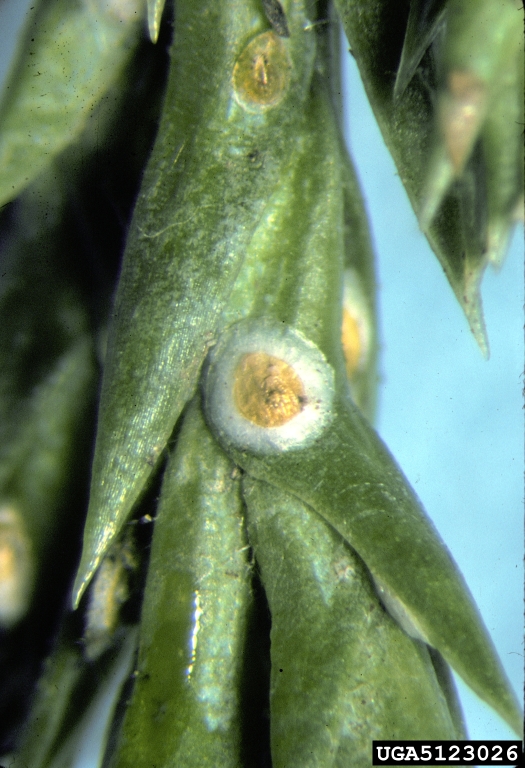
Photo: United States National Collection of Scale Insects Photographs , USDA Agricultural Research Service, Bugwood.org.
The juniper scale, Carulaspic juniperi (Figure 1), is a sporadic pest of juniper, cypress, and cedar trees in nurseries and landscapes in Georgia. Though it is native to Europe, the juniper scale is now widespread in the eastern U.S. It is an armored scale where the wax cover is not a part of its body but can actually be separated from the body. Juniper scale feeds on plant fluid with its piercing sucking mouthparts after it settles on the needles of conifers. In heavy infestations, plant vigor can be reduced, causing needle drop and twig color change from green to brown, making the plants unhealthy.
Description and Biology
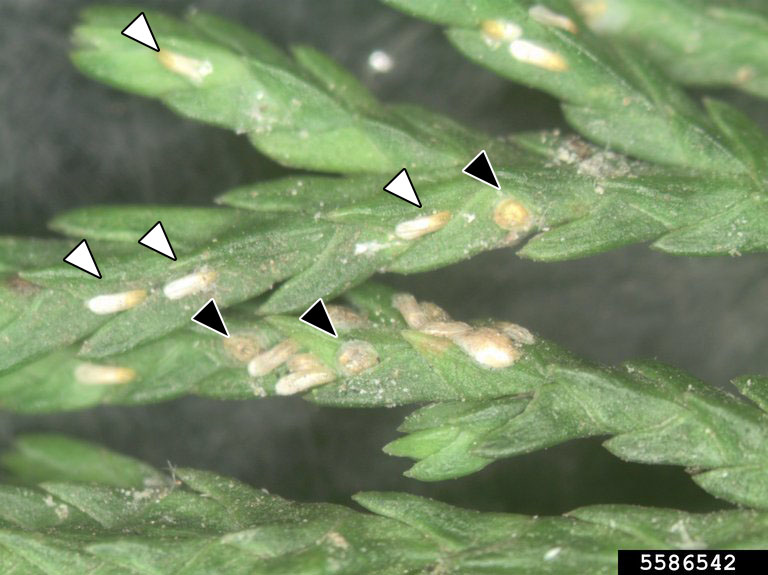
Photo: Lorraine Graney, Bartlett Tree Experts, Bugwood.org.
The wax covers of the female scale are circular, white, and about 1/16 in. in diameter (Figure 2). The immature males are smaller, white, and elongated (Figure 2). The skin that is shed from the scale body is incorporated into the cover, and it appears yellow in color. Adult females overwinter on the needles. In the spring, females produce approximately 40 eggs that hatch within 2 weeks; yellow crawlers are present in late spring. The crawlers are tiny, approximately 2 mm long and dark red in color. They are noticeable to the naked eye. The crawlers are dispersed by wind or birds to neighboring trees, where they settle by inserting their hair-like mouthparts into the plant and then molt into immobile nymphs. The female scales have three nymphal stages, whereas males have five. The winged adult males lack mouthparts and die immediately after mating. They undergo one generation per year.
Damage
Juniper scales colonize the needles of the host plants. The adults and nymphs of scales cause the damage. The affected plants lose vigor and rarely produce new growth. The new growth, if present, will not be evenly distributed, and the tree will appear stunted. Yellowing and dieback of needles are common symptoms and are obvious after infestation (Figures 3 and 4). Similar to other armored scales, the juniper scale does not produce honeydew.
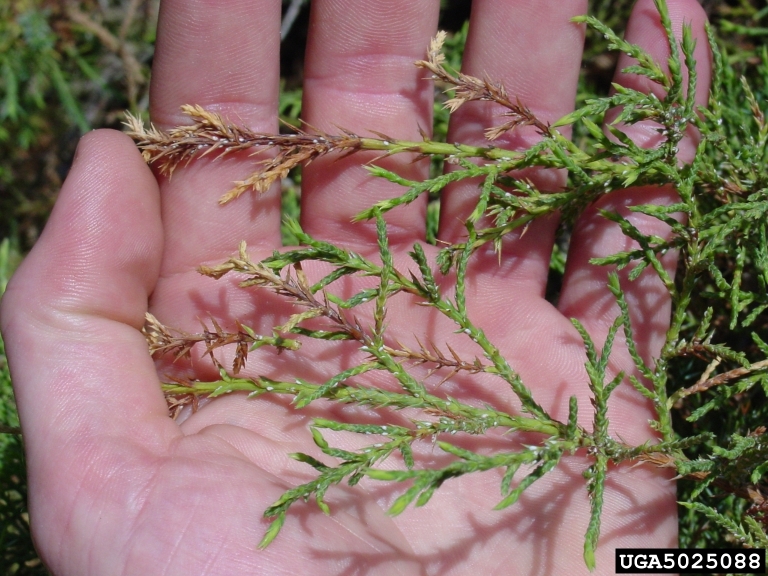
Photo: Joseph LaForest, University of Georgia, Bugwood.org.
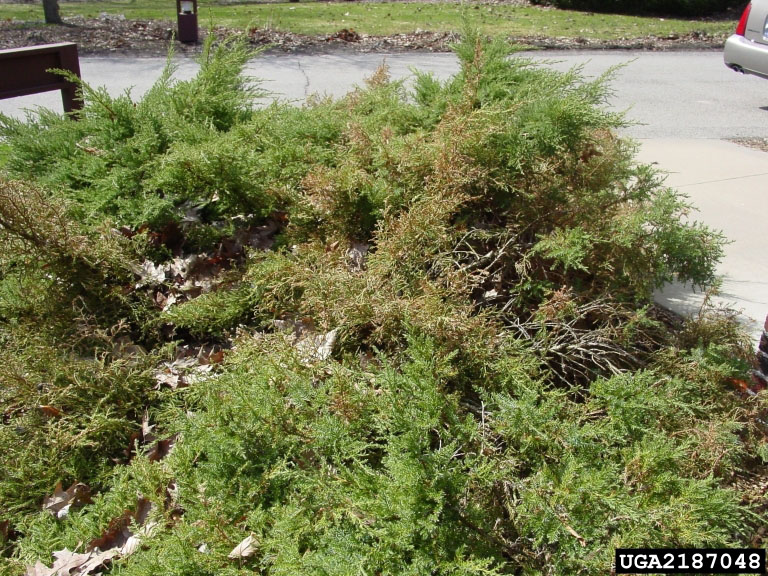
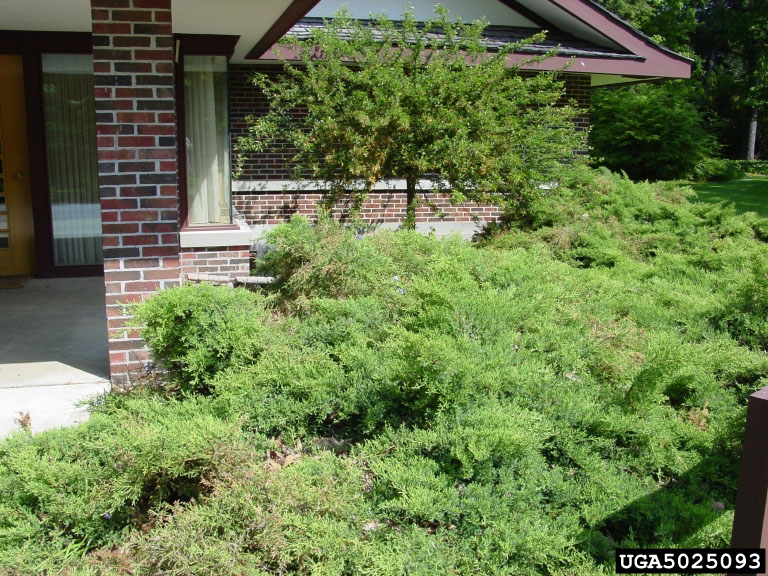
Photo: Joseph LaForest, University of Georgia, Bugwood.org.
Host Range
The juniper scale attacks various junipers, such as Pfitzer juniper, Irish juniper, Savin juniper, and Chinese juniper. It occasionally becomes a problem in landscapes and nurseries. They can infest and survive on Leyland cypress, false cypress, arborvitae, cryptomeria, incense cedar, and Eastern red cedar.
Management
Insects generally thrive on stressed plants, and the juniper scale is no different. In nurseries, scales can easily find many hosts, often of the same species. Proper irrigation, along with timely and adequate fertilizer applications, may reduce tree stress. As part of cultural management, the densities of scales can be reduced by pruning severely infested twigs. The pruned twigs should be collected in sealed plastic trash bags and left in direct sunlight. The heat generated inside the bag will kill the scales. A few tiny parasitic wasps and ladybugs have been reported as natural enemies of the juniper scale, but the impact of these biological control agents has not been studied thoroughly.
The application of dormant oil spray in the winter can cause substantial mortality of overwintering adults. Contact insecticides, such as horticultural oil or insecticidal soap, are effective if used for the crawler stage of the juniper scale. The crawlers are produced during the late spring (May). Still, it is critical to accurately determine the initial crawler activity to time the application of contact insecticides for effective management.
Double-sided sticky tape or electric tape with the sticky side facing out can be used to monitor crawler emergence, as the crawlers will be caught on the edge of the tape. Sticky tapes should be visually observed at regular intervals (at least weekly). The horticultural oil or insecticidal soap concentration should be about 1% because some species and cultivars of juniper are sensitive to higher concentrations, causing phytotoxicity. The residues of horticultural oil and soap will break down quickly in the environment and are considered an organic management approach. Crawlers can also be controlled with more persistent contact insecticides but application on adult female juniper scales is ineffective because they are protected by their thick waxy cover.
Systemic insecticides, such as dinotefuran, can be used in the fall and spring as a soil drench or granular application when a severe infestation occurs. If a systemic insecticide is chosen, the application of contact insecticide can be avoided. Contact your local Extension office for the most up-to-date control recommendations. Please carefully read the insecticide label because the label is the law. After application, the tree's health should improve, with the new growth appearing vigorous and standard in color.
References
Baker, J. (2019). Juniper scale insect PDIC factsheets. North Carolina State University Cooperative Extension. https://content.ces.ncsu.edu/juniper-scale-insect
Larson, J. (2021). Juniper scale (ENTFACT-429). University of Kentucky Martin-Gatton College of Agriculture, Food and Environment Department of Entomology. https://entomology.ca.uky.edu/ef429
Morales, G. M., Denno, B. D., Miller, D. R., Miller, G. L., Ben-Dov, Y., Hardy, N. B. (2016). ScaleNet: a literature-based model of scale insect biology and systematics. Database, 2016, Article bav118. https://doi.org/10.1093/database/bav118
Skvarla, M. J. (2023). Juniper and minute cypress scales. PennState Extension. https://extension.psu.edu/juniper-and-minute-cypress-scales
Status and Revision History
In Review on Mar 20, 2025
Published on Mar 26, 2025


























































